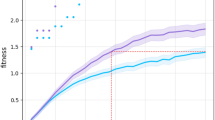Abstract
This paper describes ideas and initial experiments in embodied imitation using e-puck robots, developed as part of a project whose aim is to demonstrate the emergence of artificial culture in collective robot systems. Imitated behaviours (memes) will undergo variation because of the noise and heterogeneities of the robots and their sensors. Robots can select which memes to enact, and—because we have a multi-robot collective—memes are able to undergo multiple cycles of imitation, with inherited characteristics. We thus have the three evolutionary operators: variation, selection and inheritance, and—as we describe in this paper—experimental trials show that we are able to demonstrate embodied movement-meme evolution.
Similar content being viewed by others
References
Alissandrakis A, Nehaniv C, Dautenhahn K (2002) Imitation with ALICE: learning to imitate corresponding actions across dissimilar embodiments. IEEE Trans Systems Man Cybern Part A Systems Humans 32(4): 482–496
Alissandrakis A, Nehaniv C, Dautenhahn K (2007) Solving the correspondence problem in robotic imitation across embodiments: synchrony, perception and culture in artefacts. In: Nehaniv C, Dautenhahn K (eds) Imitation and social learning in robots, humans and animals, Chap 12. Cambridge University Press, Cambridge, pp 249–273
Alissandrakis A, Nehaniv CL, Dautenhahn K (2003) Synchrony and perception in robotic imitation across embodiments. In: IEEE international symposium on computational intelligence in robotics and automation, pp 923–930
Billard A, Hayes G (1999) DRAMA, a connectionist architecture for control and learning in autonomous robots. Adapt Behav 7(1): 35–63
Blackmore S (1999) The meme machine. Oxford University Press, Oxford
Dautenhahn K (1995) Getting to know each other: artificial social intelligence for autonomous robots. Robot Auton Syst 16: 333–356
Dawkins R (1976) The selfish gene. Oxford University Press, Oxford
Demiris Y, Hayes G (2002) Imitation as a dual-route process featuring predictive and learning components: a biologically-plausible computational model. In: Dautenhahn K, Nehaniv C (eds) Imitation in animals and artefacts, Chap 13. MIT Press, Cambridge
Demiris Y, Khadhouri B (2005) Hierarchical, attentive, multiple models for execution and recognition (HAMMER). In: Proceedings of ICRA 2005
Gerkey BP, Vaughan RT, Stoy K, Howard A, Sukhatme GS, Matarić MJ (2001) Most valuable player: a robot device server for distributed control. In: IEEE/RSJ international conference on intelligent robots and systems (IROS), pp 1226–1231
Hayes G, Demiris J (1994) Robot controller using learning by imitation. In: Proceedings of 2nd international symposium on intelligent robotic systems, pp 198–204
Johnson M, Demiris Y (2004) Abstraction in recognition to solve the correspodence problem for robot imitation. In: Proceedings of towards autonomous robotic systems (TAROS), pp 63–70
Liu W, Winfield AFT (2011) Open-hardware e-puck Linux extension board for experimental swarm robotics research. Microprocess Microsyst 35(1): 60–67
Mataric MJ (2000) Getting humanoids to move and imitate. IEEE Intell Syst Appl 15(4): 18–24
Meuth R, Lim MH, Ong YS, Wunsch D (2009) A proposition on memes and meta-memes in computing for higher-order learning. Memetic Comput 1: 85–100
Mondada F, Bonani M, Raemy X, Pugh J, Cianci C, Klaptocz A, Magnenat S, Zufferey JC, Floreano D, Martinoli A (2009) The e-puck, a robot designed for education in engineering. In: Proceedings of 9th conference on autonomous robot systems and competitions, pp 59–65
Nehaniv, C, Dautenhahn, K (eds) (2007) Imitation and social learning in robots, humans and animals. Cambridge University Press, Cambridge
Nehaniv CL, Dautenhahn K (2002) The correspondence problem. In: Imitation in animals and artifacts, pp 41–61. MIT Press, Cambridge
Nehaniv, CL, Dautenhahn, K (eds) (2002) Imitation in animals and artefacts. MIT Press, Cambridge
Scassellati B (1999) Knowing what to imitate and knowing when you succeed. In: Proceedings of AISB’99 symposium on imitation in animals and artefacts, pp 105–113
Vaughan R (2008) Massively multi-robot simulation in stage. Swarm Intell 2(2–4): 189–208
Winfield AFT, Erbas MD (2010) Screen recording showing animation of fig. 3. http://sites.google.com/site/artcultproject/mc-fig3
Winfield AFT, Erbas MD (2010) Screen recording showing animation of fig. 6. http://sites.google.com/site/artcultproject/mc-fig6
Winfield AFT, Griffiths F (2010) Towards the emergence of artificial culture in collective robot systems. In: Levi P, Kernbach S (eds) Symbiotic multi-robot organisms: reliability, adaptability, evolution. Springer, Berlin
Author information
Authors and Affiliations
Corresponding author
Rights and permissions
About this article
Cite this article
Winfield, A.F.T., Erbas, M.D. On embodied memetic evolution and the emergence of behavioural traditions in Robots. Memetic Comp. 3, 261–270 (2011). https://doi.org/10.1007/s12293-011-0063-x
Received:
Accepted:
Published:
Issue Date:
DOI: https://doi.org/10.1007/s12293-011-0063-x




